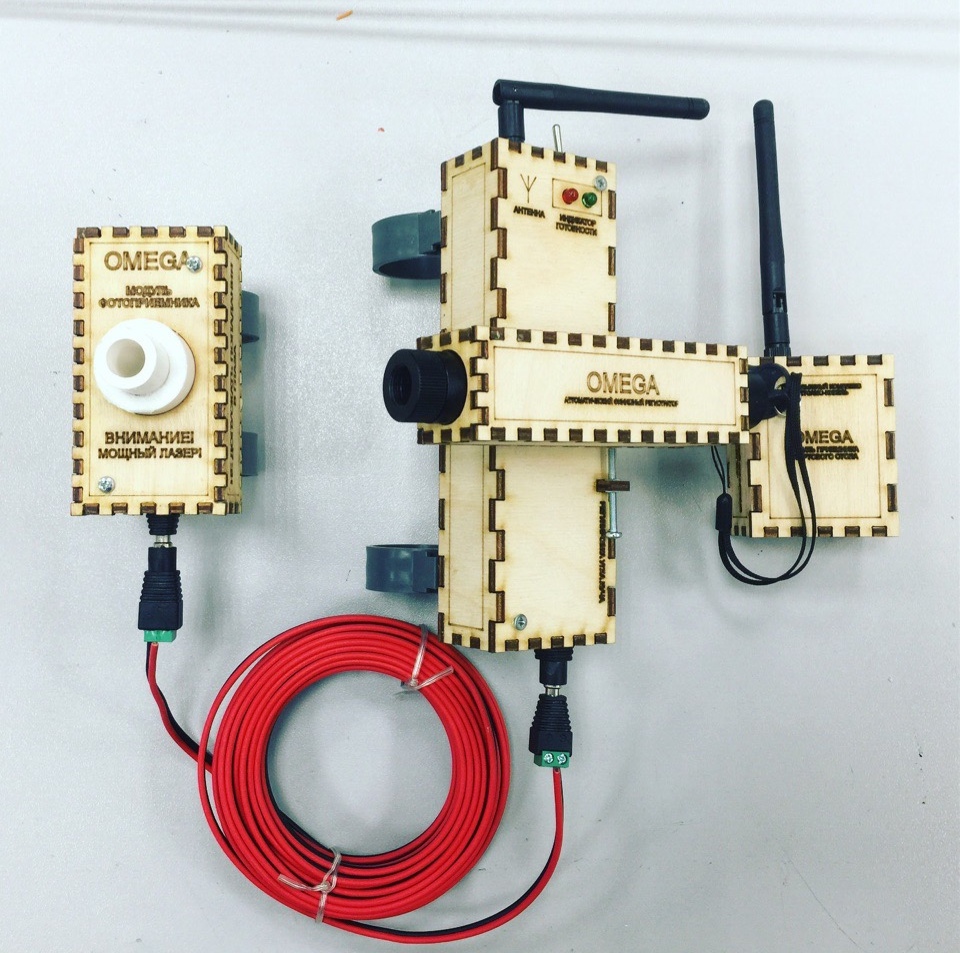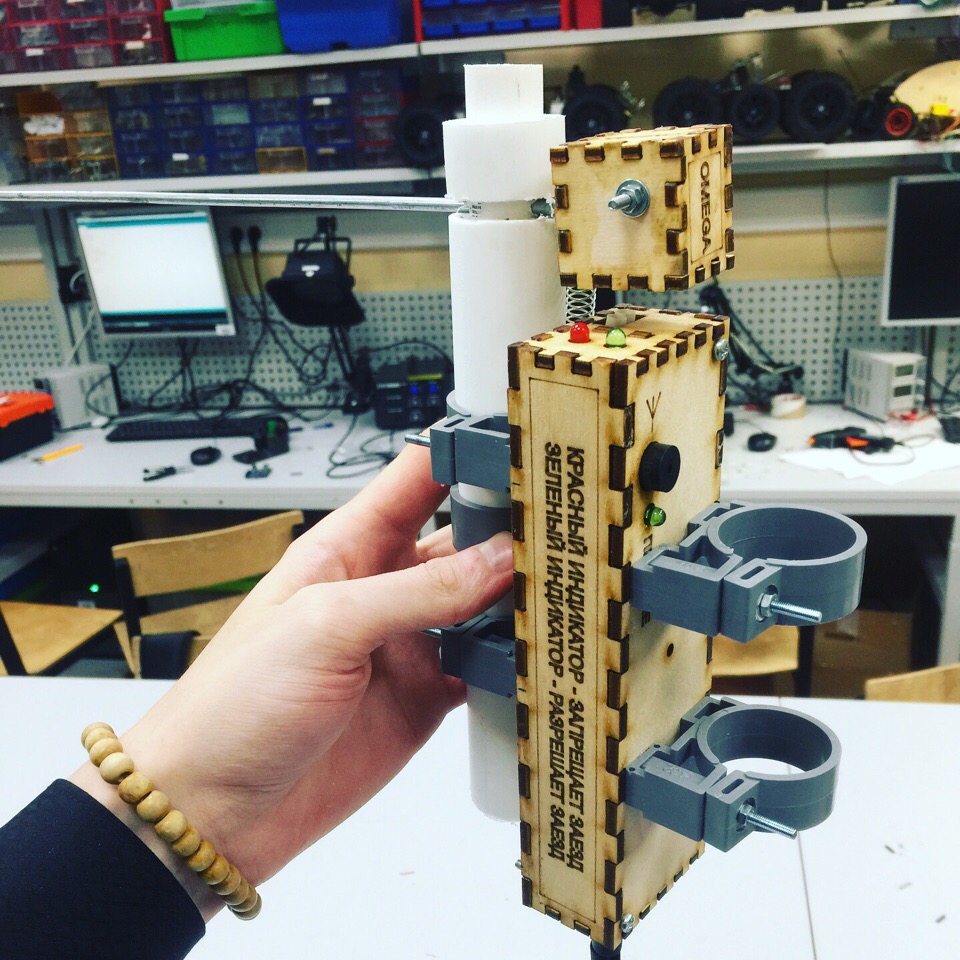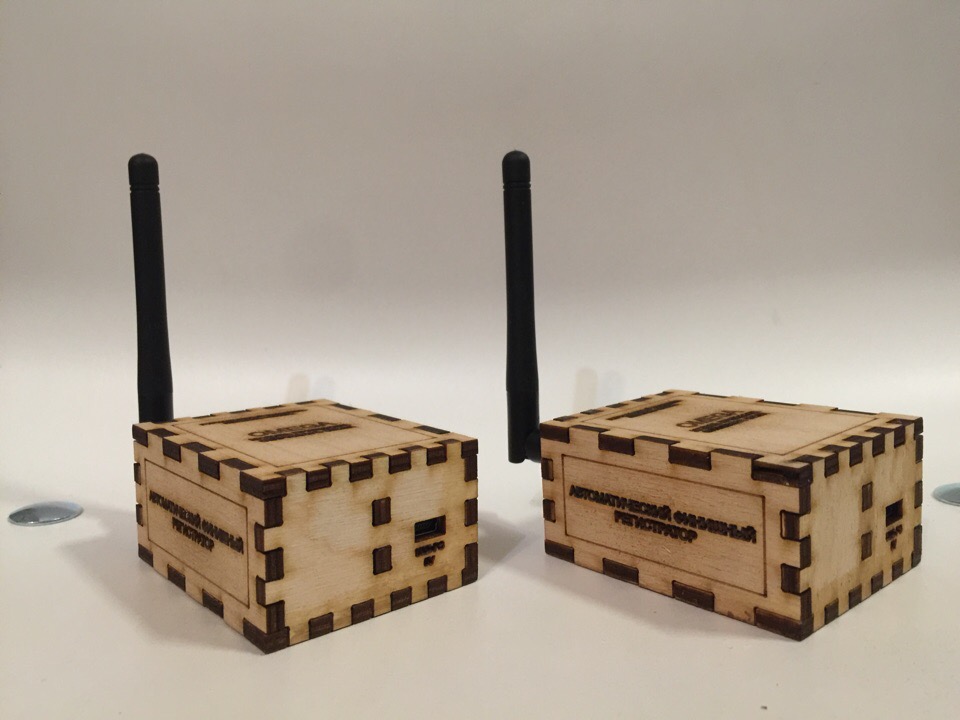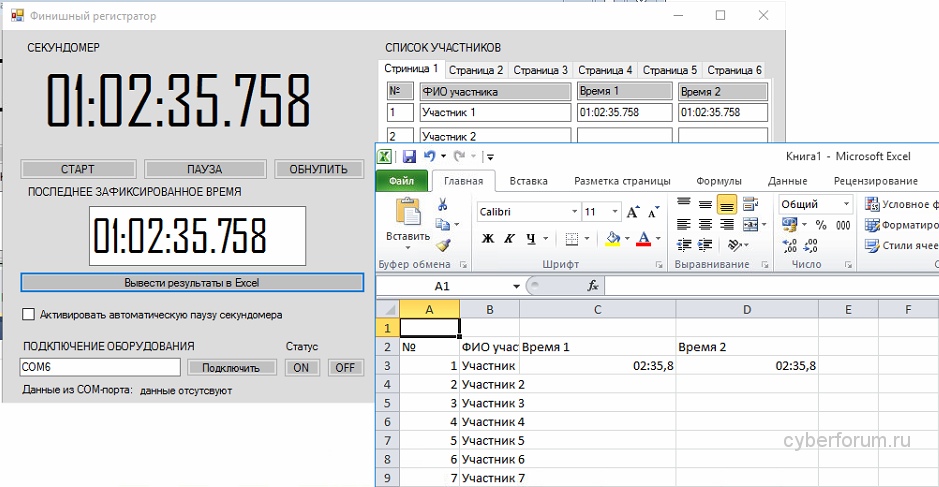OMEGA - Automation of counting time at sporting events
Hello everyone, my name is Sergey.
I am the head of the educational project " SERVODROID ". My project is developing easy-to-repeat robots for children and adults. I myself teach robotics in St. Petersburg. But I am also an athlete, and one of my favorite sports areas is winter sport - slalom, which will be discussed further.

In the vast expanses of our country, there are many wonderful places, the existence of which ordinary people may not suspect. But since I am from such places, I would like to tell about it in this project. In the north of Russia, in the Murmansk region, there is one inconspicuous, but very united city, more precisely a settlement called Nickel- named after the very element from the periodic table, which is mined in this city. The population of the city is about 10,000 people. And who would have thought that in such a sparsely populated city there could be a real ski complex, as it is usually called in large cities. For the population of 10 k - this is a real skier, on which sports sections are held, children and adults train and study, there is their own ski lift, you can ski and even snowboard freeride!
Now the ski continues to continue its work on training new champions of Russia! For a city, however small as ours is - any victory of athletes on this mountain is like a victory for the whole country - so much we cheer for our athletes.
Below you can watch a video about how competitions are held on the mountain and who rides on it:
Since I am an athlete myself and, concurrently, I am a teacher, I understand how important it is for the younger generation to have the opportunity for self-development and demonstration of their knowledge and skills - and, after all, sports competitions for this are a huge motivator!
There are no modern systems on our skis that allow you to record how long a participant has to go the distance and basically, measurements are taken in the old manner - announcing the start and finish of the participant on the radio using the referee’s stopwatch. Yes, the method is proven, stable, but I have long wanted to add novelty and convenience for the judges and the participants themselves so that they can more effectively conduct their trainings and independently monitor their results. For this, I came up with a project in which I want to create a simple and reliable option, I’m not afraid to say, the domestic equivalent of the registrar.
As it is known from sports competitions - the task of the participant to get from point “A” to point “B” in a very short time. And in order to take this time into account, it is necessary to automate the process in which the countdown of the timer began strictly from the intersection of the starting flag and stopped when crossing the finish line. Back in 2016, I set about trying to assemble such a device. It should be noted that the idea was supported and a month later I tested a demo sample of the device on the mountain. The device was completely wired - a wire was routed across the mountain at a distance of 300 meters, along which signals went to the judge's computer. How it looked, you can see here. The system worked, but the use of wires would have led to their constant breakdown (fractures when folding and unfolding into the bay) and freezing the judges' computer, which would have to be installed in the cold outside.
On the video below, a demonstration of the working version of the new version of the system, which works wirelessly, allowing the judge to be in comfortable conditions, and the process of deploying and launching the system to work — in minutes:
Video: OMEGA - Practical Test 4:28
In 2019, I decided to rework the hardware and replace the wires with radio modules. Having studied the existing variants of radio modules on the market, I stopped at quite promising radio communication modules NRF24. These communication modules will allow you to transfer data over a distance of up to 1,000 km, and in my case, for all 2,000 km!
1. The launch pad module is a device that incorporates an Arduino on-board mini-computer, NRF24L01 communication modules, as well as special sensors that record the beginning of a participant's movement. In addition to the sensors, the module is equipped with special sound and light indicators, which make it clear to the participant that the start is allowed or prohibited. This allows you to unload the work of judges and controllers, allowing them to focus on the quality of the start of the participant and his travel on the track.

(In the photo: the “starting” table module with the starting flag and fastener installed for mounting on the supports driven in into the snow)
2. Finishing table module- This is a device that incorporates the same set of components as the module above, but there are some differences: to register the intersection of the finish segment, a powerful laser beam is used, which can shine at sufficiently remote distances, which allows using the system not only in ski conditions. The module has an antenna, fastening mechanisms, with which it can be fixed to any round objects, even to a shovel stalk dug into the snow!

(Pictured: Finishing table module with installed laser module and 10-meter cable for measuring the laser beam - photodetector)
3. Radio communication modules- these small boxes are able to receive and send signals at a distance of up to 1000-2000 meters (a large distance due to two identical models with an external antenna and amplifier), which means that the judge can get comfortable conditions in the referee’s house, and calmly, warm and with a cup of coffee to register arrivals of each of the participants. In the case of a wired system - it was a great discomfort - I know by myself, as I was sitting after controlling the work at the finish =) The modules are connected to the computer via a USB cable and powered by power from a laptop. A fairly simple and effective solution for judge mobility and ease of system deployment.

(Pictured: Receiver modules that connect to the computer on which the software will run with a timer)
4. Software is the most important part of the system.
The software is developed in C # and C / C ++. The main task of the program is to connect the hardware and provide the judge with a convenient and understandable (simple) work interface. The program can work both in manual and automatic mode, independently start the timer at the start of the participant and independently stop the timer when crossing the finish line, recording the time in the table. Knowing the experience of the competitions - it often happens that the participants do not have time to observe their order, and the program already has such an option. The program also insures the judge against accidental shutdown / closure of the program with the results - by forcibly saving the data and outputting it to Excel.

(In the photo: The program interface in which the judge works, registers the time and controls the work of the iron)
Since the initial calculation was based on the easy availability of the used radio components in a small town, such as my village, I tried to choose the most popular and easily accessible components.
At the moment I am already testing and debugging the hardware and software part of the system - the other day I was selected for a ski and there I conducted tests on the mountain.
I collect this project for myself - so that the brains do not relax and get some new information, and of course I would like to thank my skier for helping me to learn snowboarding, gave me the opportunity to pump my skills to participate in local and regional competitions =) Well and of course I want to be useful!
I am the head of the educational project " SERVODROID ". My project is developing easy-to-repeat robots for children and adults. I myself teach robotics in St. Petersburg. But I am also an athlete, and one of my favorite sports areas is winter sport - slalom, which will be discussed further.

In the vast expanses of our country, there are many wonderful places, the existence of which ordinary people may not suspect. But since I am from such places, I would like to tell about it in this project. In the north of Russia, in the Murmansk region, there is one inconspicuous, but very united city, more precisely a settlement called Nickel- named after the very element from the periodic table, which is mined in this city. The population of the city is about 10,000 people. And who would have thought that in such a sparsely populated city there could be a real ski complex, as it is usually called in large cities. For the population of 10 k - this is a real skier, on which sports sections are held, children and adults train and study, there is their own ski lift, you can ski and even snowboard freeride!
Brief historical background
In the 1950s, Nickel enthusiast Alexei Korovin and his friends began chopping a clearing on the Lysaya hill, which was then thickly overgrown. In 1966, he developed a rope tow and developed the first group of schoolchildren for classes. From this set and now Nikolay Saltykov and Valery Zabara ride.
In the 70-80 biennium, the team traveled to the regional competitions, where it surely occupied a place in the top three of the 15 teams. Pupil of the Nickel ski section master of sports Oleg Zuev was a repeated champion of the North Festival, the winner and prize-winner of the primacy of the Soviet Union. Subsequently, he worked as a coach in the city of Kirovsk. His daughter is the champion of Russia in slalom, son Stepan - a member of the Russian national team, champion of Russia, winner of many competitions of the European Championship. Novokuznetsk coach A. Novikov brought up the champion of Russia Elena Prosteva. He is also a graduate of the Nickel ski.
Present tense
Now the ski continues to continue its work on training new champions of Russia! For a city, however small as ours is - any victory of athletes on this mountain is like a victory for the whole country - so much we cheer for our athletes.
Below you can watch a video about how competitions are held on the mountain and who rides on it:
The essence of this project
Since I am an athlete myself and, concurrently, I am a teacher, I understand how important it is for the younger generation to have the opportunity for self-development and demonstration of their knowledge and skills - and, after all, sports competitions for this are a huge motivator!
There are no modern systems on our skis that allow you to record how long a participant has to go the distance and basically, measurements are taken in the old manner - announcing the start and finish of the participant on the radio using the referee’s stopwatch. Yes, the method is proven, stable, but I have long wanted to add novelty and convenience for the judges and the participants themselves so that they can more effectively conduct their trainings and independently monitor their results. For this, I came up with a project in which I want to create a simple and reliable option, I’m not afraid to say, the domestic equivalent of the registrar.
OMEGA - Automatic Finishing Recorder System
As it is known from sports competitions - the task of the participant to get from point “A” to point “B” in a very short time. And in order to take this time into account, it is necessary to automate the process in which the countdown of the timer began strictly from the intersection of the starting flag and stopped when crossing the finish line. Back in 2016, I set about trying to assemble such a device. It should be noted that the idea was supported and a month later I tested a demo sample of the device on the mountain. The device was completely wired - a wire was routed across the mountain at a distance of 300 meters, along which signals went to the judge's computer. How it looked, you can see here. The system worked, but the use of wires would have led to their constant breakdown (fractures when folding and unfolding into the bay) and freezing the judges' computer, which would have to be installed in the cold outside.
On the video below, a demonstration of the working version of the new version of the system, which works wirelessly, allowing the judge to be in comfortable conditions, and the process of deploying and launching the system to work — in minutes:
Video: OMEGA - Practical Test 4:28
What has changed and what to do
In 2019, I decided to rework the hardware and replace the wires with radio modules. Having studied the existing variants of radio modules on the market, I stopped at quite promising radio communication modules NRF24. These communication modules will allow you to transfer data over a distance of up to 1,000 km, and in my case, for all 2,000 km!
What the system consists of
1. The launch pad module is a device that incorporates an Arduino on-board mini-computer, NRF24L01 communication modules, as well as special sensors that record the beginning of a participant's movement. In addition to the sensors, the module is equipped with special sound and light indicators, which make it clear to the participant that the start is allowed or prohibited. This allows you to unload the work of judges and controllers, allowing them to focus on the quality of the start of the participant and his travel on the track.

(In the photo: the “starting” table module with the starting flag and fastener installed for mounting on the supports driven in into the snow)
2. Finishing table module- This is a device that incorporates the same set of components as the module above, but there are some differences: to register the intersection of the finish segment, a powerful laser beam is used, which can shine at sufficiently remote distances, which allows using the system not only in ski conditions. The module has an antenna, fastening mechanisms, with which it can be fixed to any round objects, even to a shovel stalk dug into the snow!

(Pictured: Finishing table module with installed laser module and 10-meter cable for measuring the laser beam - photodetector)
3. Radio communication modules- these small boxes are able to receive and send signals at a distance of up to 1000-2000 meters (a large distance due to two identical models with an external antenna and amplifier), which means that the judge can get comfortable conditions in the referee’s house, and calmly, warm and with a cup of coffee to register arrivals of each of the participants. In the case of a wired system - it was a great discomfort - I know by myself, as I was sitting after controlling the work at the finish =) The modules are connected to the computer via a USB cable and powered by power from a laptop. A fairly simple and effective solution for judge mobility and ease of system deployment.

(Pictured: Receiver modules that connect to the computer on which the software will run with a timer)
4. Software is the most important part of the system.
The software is developed in C # and C / C ++. The main task of the program is to connect the hardware and provide the judge with a convenient and understandable (simple) work interface. The program can work both in manual and automatic mode, independently start the timer at the start of the participant and independently stop the timer when crossing the finish line, recording the time in the table. Knowing the experience of the competitions - it often happens that the participants do not have time to observe their order, and the program already has such an option. The program also insures the judge against accidental shutdown / closure of the program with the results - by forcibly saving the data and outputting it to Excel.

(In the photo: The program interface in which the judge works, registers the time and controls the work of the iron)
What does this system consist of?
Since the initial calculation was based on the easy availability of the used radio components in a small town, such as my village, I tried to choose the most popular and easily accessible components.
- Radio module NRF24L01 + PA + LNA 1100m - 4 pcs
- 4 mm plywood sheet - for cutting boxes and necessary elements
- Fee Arduino UNO - 4 pieces
- Adapter for NRF24L01 - without it, these communication modules behave inadequately
- Boxes and plywood system design (cut everything on a laser machine)
- Software development with the ability to update (update mainly for Arduino and C # judging program, complementing and improving functionality)
- 10 meter cable connecting the finishing table details
- A laser module is essentially any laser pointer. I chose this because it is very popular in stores with all sorts of entertaining trinkets and if that - you can quickly replace it by buying a new one.
- Batteries for portable modules
- Consumables, glue, wires, indicators, buttons, connectors.
At the moment I am already testing and debugging the hardware and software part of the system - the other day I was selected for a ski and there I conducted tests on the mountain.
I collect this project for myself - so that the brains do not relax and get some new information, and of course I would like to thank my skier for helping me to learn snowboarding, gave me the opportunity to pump my skills to participate in local and regional competitions =) Well and of course I want to be useful!
If you are also interested in sports and you are fond of automation or, in fact, sports, then I will be glad for your support - more on this here (:You can follow the development and progress of development and practical application in my group on VKontakte .
